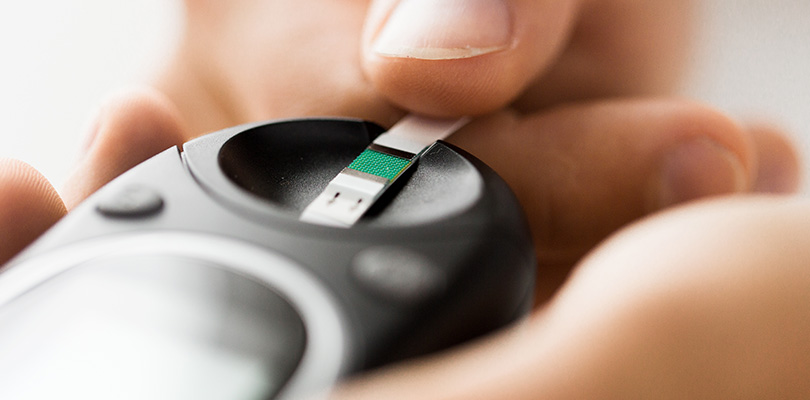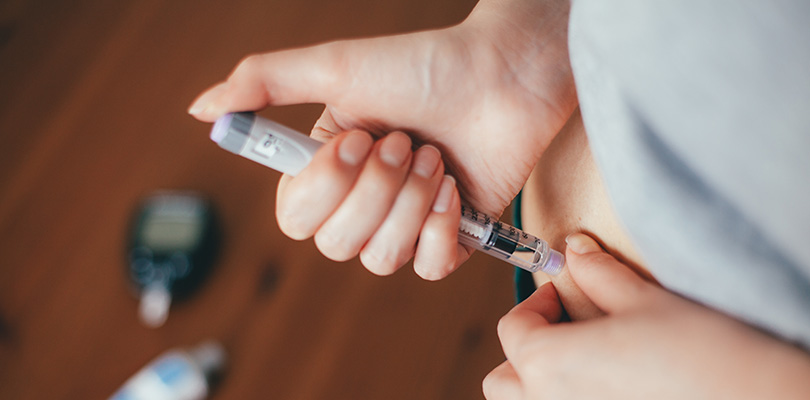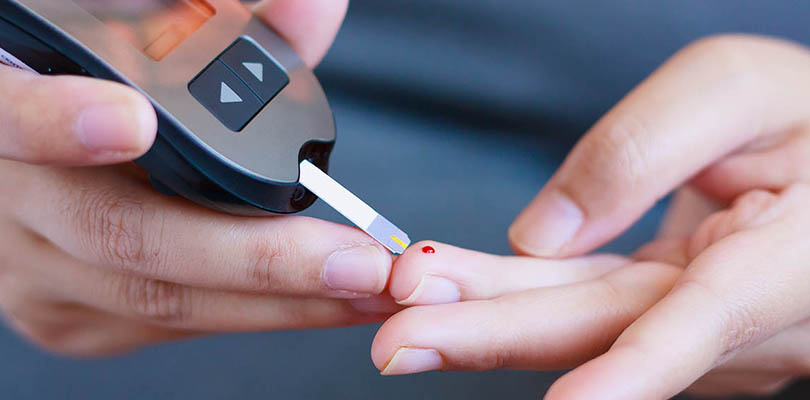What Are Diabetic Supplies?
Whether you're a type 1 or a type 2 diabetic, diabetic supplies and tools are needed to monitor and manage your condition. These supplies and tools include blood glucose meters, test strips, and lancets, and a few others. Below you will learn more about the diabetic supplies you need and their uses.
Blood Testing Diabetic Supplies
Diabetes testing is vital to the successful management of your blood glucose levels. Blood testing for diabetes involves a number of different elements, many of which are performed daily by the person with diabetes themselves or by a family member.
Without regular diabetes tests, you can lose track of your blood sugar levels, which can be quite dangerous. Common diabetic supplies for blood sugar testing include glucose meters and testing strips.
Diabetes Glucose Meters
A blood glucose monitor is a machine that takes the small sample of blood from a finger prick and analyzes it for blood glucose levels. Tests using blood glucose monitors are important because they allow the person with diabetes to adjust their medication, activity level, and food intake depending on the glucose level in their blood.
When you're shopping for blood sugar meters, there are a couple of things you should keep in mind.
Consider, first, how the blood sample is taken. Most meters come with a small pen that pricks the finger; however, some pens can take samples from other body parts, such as the arm, as well. Look at how the lancets are used in the pen. Some pens use a cartridge that has several lancets in one container, while others use individual lancets. Cartridges can be more convenient because you don't have to change the lancet every time you do a test.
Also, find out how much blood a meter requires for the sample. The newest meters can get an accurate reading from the smallest drop of blood.
Finally, you may, of course, also want to look at how much the meters and their test strips cost. However, keep in mind that you don't want to sacrifice accuracy for a cheaper price.
Diabetes Blood Glucose Testing Strips
Blood glucose test strips are an important tool for diabetics in the monitoring and maintenance of blood sugar levels. Diabetics need to test their blood sugar levels regularly; however, the diabetes test strips you use will depend on the brand and type of glucometer you own.
It's important to always purchase glucose testing strips that are compatible with your particular blood glucose meter, since the wrong strip may provide a false reading. False readings can be very dangerous because you need to be aware of your glucose levels before you eat, take medication or change your activity levels. Even when shopping for discount diabetes supplies, you have to remember that you can't sacrifice quality and accuracy for the price.
There are two different types of strips you can choose from. Some strips come with a plastic dot in the center of the strip, on which you drip the blood from a finger prick. Other strips have sensitive sections at the ends, which can be touched to the finger prick spot and draw the blood up into them.
The latter is more convenient for people with diabetes who prefer to perform tests using blood samples from their arms since the drop of blood doesn't have to land on one particular small area.
Diabetic Lancets
Diabetic lancets are designed for type 1 and type 2 diabetics to use in the regular monitoring of their blood glucose levels. The lancet you choose will depend on the blood glucose meter you use.
There are two distinct types of lancets available. A single lancet can be used for one blood test and is usually best used on the finger. While there is always an element of pain to anything that breaks the skin, most lancets are designed to cleanly enter the skin and release only enough blood as is required by the blood glucose meter.
You may also be able to use what is referred to as a lancet cartridge with your blood glucose meter. A lancet cartridge contains several individual lancet tips, which means you discard the cartridge only after several uses. This is convenient because it allows you to travel with fewer diabetic supplies, and it is a more environmentally friendly option, as well.
Insulin Injections, Syringes, Pumps, Pens, and Coolers
There are several different options available when you're selecting an insulin injection system. Regardless of your situation, you should always discuss your treatment and its administration with your doctor or diabetes management team. Never take it upon yourself to try new technologies, since you can't be sure that they work with your already-established routine.
Insulin Syringes
While diabetics used to be sent home with large, imposing steel needles, today's disposable insulin syringes are small, discreet, and are designed to minimize the pain of regular injections.
Diabetes and dizziness often go hand-in-hand. Though this symptom may not be an emergency, you shouldn’t ignore your dizzy spell.
Insulin needles come in a variety of shapes and sizes, and you should discuss with your doctor which is best for your needs. The type of needle you use will depend on a number of different factors, including the type of diabetes testing you do, the kind of insulin or medication(s) you're using, as well as your age, body type, and lifestyle.
Your doctor will attempt to set you up with the needle that works best for your situation, minimizing pain and the lasting effects of continued injection, such as skin damage and the creation of scar tissue.
Insulin Pumps
The diabetes insulin pump is a relatively new invention. The insulin pump is surgically implanted into the diabetic patient, and it reduces or eliminates the need to inject insulin through insulin pens or syringes.
Both diabetics and those who help diabetics maintain their blood glucose levels often find that the pump is an easier, more convenient and more reliable way to administer insulin. This is especially true not only for those who have been administering injections for years but for young diabetic children and their parents.
Because the insulin infusion pump doesn't require an injection to administer insulin, those who manage their diabetes with a pump often report less pain and fewer of the other side effects that commonly come with regular insulin injections.
Furthermore, the pump is able to provide a continuous supply of insulin to the body, which is a better way to maintain blood glucose levels than intermittent injections.
Insulin Pens
Insulin pens are the modern-day solution for insulin injections. More accurate and easier to use than traditional insulin syringes, the insulin pen needle can make administering your daily diabetes treatment simple.
Injection pens work in the same way as a traditional needle: the pen tip pierces the skin in order to inject insulin directly into the body. Sometimes incorrectly referred to as glucose pens, injection pens are used to administer insulin and aren't an option for treating instances of low blood sugar.
Although the pen is simply another version of a needle, most patients find that its smaller size is more comfortable and convenient for injections. Further, the look of the pen makes it less noticeable than a syringe, so many diabetics feel more comfortable carrying it in public. Often, those who aren't familiar with insulin injection supplies don't even realize that the pen is a needle.
Insulin Coolers
Insulin coolers come in a variety of shapes, sizes, and styles, and can be completely customized to your needs. Sometimes called insulated wallets, these coolers offer insulin protection by keeping it safe from impact and ensuring a steady, cool temperature for storage.
Insulin coolers are important for people with type 1 diabetes because many of them need to transport their insulin regularly. The cooler allows type 1 diabetics to enjoy outdoor activities and travel without worrying about damaging or spoiling their treatment.
The type of cooler you choose will depend on the injection system you need to transport. If you use insulin syringes, your cooler will have to have space for vials and the syringes themselves. If you use an insulin pen, look for a cooler that will protect the pen itself, and also store pen tips for convenient use.
Alcohol Swabs
People with diabetes who inject insulin directly into the skin, need to pay special attention to hygienic practices. It's important to use alcohol swabs to clean your skin in preparation for any piercing, be it by insulin injection or finger prick.
Since you will use an alcohol wipe every time you pierce your skin for medical purposes, you should keep a lot on hand—you may find yourself going through more than a dozen a day. When you purchase wipes, make sure they are individually sealed so that they don't dry out before you get the chance to use them. Store the wipes in a cool, dry place; avoid keeping them in the bathroom because heat and moisture can damage the wipe.
Alternatively, you can clean the area for the injection using rubbing alcohol or iodine with cotton swabs or foam swabs.
Diabetes Medical Bracelets
Diabetes medical jewelry can be worn on any part of the body that will be obvious to emergency workers, including on the wrist or around the neck. Diabetic medical bracelets are the most common choice and are a great option because medical professionals know to check the wrist for medical information.
When you're living with diabetes, you have to make sure that other people are aware of your situation. Medical alert jewelry is important because it provides medical workers, as well as anyone who may offer assistance in a time of need, the information they need to care for you properly.
It's important to let people know that you have diabetes so that they can be aware of the signs of trouble. It's also important because some medications aren't safe for diabetics, and if you're unable to share that information with medical workers, they may administer something to you that will conflict with your condition.







